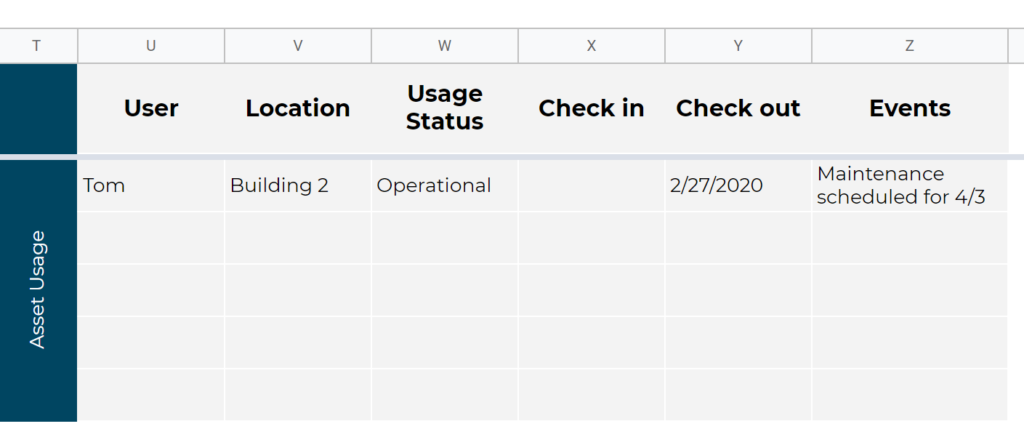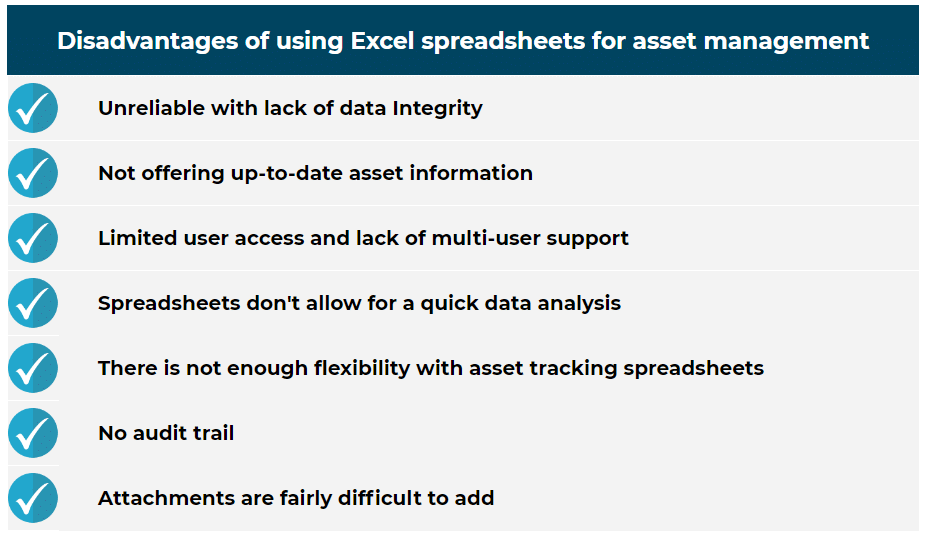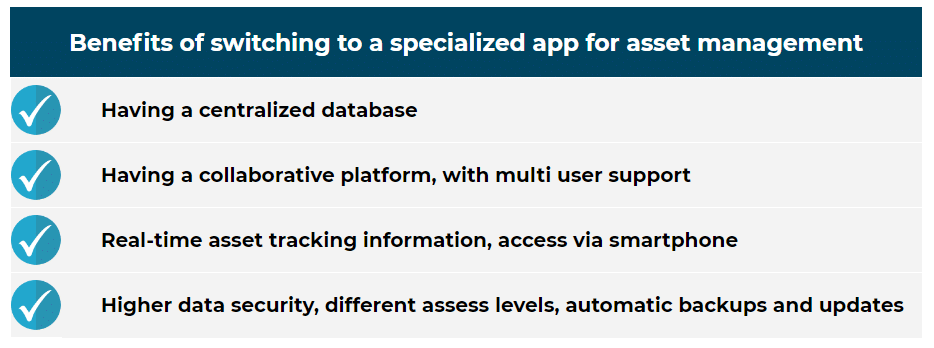Using a spreadsheet to track assets has some advantages, but also many disadvantages. Making the right decisions about asset tracking for your organization will help boost efficiency and client satisfaction, so here are some aspects to keep in mind.
Weighing one’s options regarding the use of an asset management tracking spreadsheet before committing one way or the other is a major aspect of implementing a new system.
In this article...
How Do Companies Use Spreadsheets to Keep Track of Assets?
While some might consider spreadsheets out of date, others rely on them exclusively to track their assets. There are several reasons why, and it usually depends on the type of organization and the function of the spreadsheet.
Micro Businesses with low inventory that focus on service, for example, often use spreadsheets to keep track of assets.
Here are a few examples:
- Timesheet tracking
- Keeping track of information which does not change very often
- Using columns for description and classification
Companies must decide ahead of time how to divide or subdivide groups of items and data in order to build a useful spreadsheet. These must be manually updated. However, since there’s so much information to track, and the process is not automated, nearly 90% of spreadsheets contain errors.
What Should an Asset Tracking Spreadsheet Include?
Asset management Excel spreadsheets need to contain a number of categories of information in order to keep asset tracking data organized. If employees input this information manually, concentration and accuracy are essential.
Basic Information About the Asset
This information represents the baseline data which helps keep one asset distinct from another. Here is an example.
Asset ID: Includes barcodes, unique tracking IDs, or serial numbers. This might consist of 9 to 12 numbers or more.
Product Model Number: A shorter code which might be alphanumeric, used by the company to clarify assets within larger groups or smaller subgroups. Example: AS928.
Name: Descriptor of what an item is, and usually decipherable by outsiders. The name might include manufacturer information in order to differentiate the product from others. For example, a car part might be labeled “3-inch Nismo air filter.”
Purchase date: Several different departments, including accounting or regulation compliance, might be interested in the date when an item was brought into the organization.

Quantity: Knowing how many items are on hand is essential for stocking and customer assistance. This might be broken into the number of items that have been ordered, the elements of the supply chain, and the quantity presently on hand or in a warehouse.
Category, Group, and Subgroup (if necessary): This differentiates between types (IT, cooking hardware, seasonal), groups (computers, stove items, fall), and sometimes subgroups (Asus laptop, spatula, Thanksgiving). These help operators gather and study the data in different ways.
Condition: Many organizations track items throughout their lifecycle. Noting whether they are new, in need of repair, or ready for disposal helps employees and members of management differentiate between items and make decisions about them.
All of this information is a starting point. Other data is needed in order to make the most of an asset tracking spreadsheet.
Other Asset Details
What else can a company track about an asset in an asset tracking spreadsheet? Additional details can aid in identifying an asset, particularly for employees who work with customers and must process information quickly.
Picture URL: An image of the item helps employees positively identify an item
Document Attachment URL: This information is particularly useful for maintenance employees or contractors who are on hand for specialized repairs or updating work. It might involve maintenance records, manufacturer recommendations, or a user manual.
Price: Unit price, the retail price, or various subcategories.
Vendor: The vendor is the supplier of the item. For example, a restaurant might source cheesecake from one supplier and crab cakes from another.

Maintenance Provider: Information about the subcontractor, warranty provider, or specialist who services the item must be up to date.
Warranty Expiry Date/Insurance Details: This data alerts employees to when a warranty might expire, and what claims might have previously been made. The insurance details contain information about past claims, authorized repair shops, or policy claim numbers.
Notes: Information about a certain item that differentiates it from others, as well as data about how it operates (glitches, particular characteristics, etc.), is useful to maintenance employees or customers.
For example: “Left door sticks, taken to Lisa’s Repair Shop on 5/25/18, does not affect performance.”
The statistics, images, and other material included here can provide specialized data, allowing employees to zero in on the item.
Information About Asset Usage
Depending on its role in an organization, a particular asset can be tracked in an asset tracking spreadsheet as long as the information is regularly updated.
Users: Who is using the item? Is it an employee, client, student, or another person? What is the contact information? This is vital in tracking who is in possession of an asset, or at least who had it last.
Location: This can involve an area as large as a nation (such as Ecuador) or as small as a room (D 28, HD Annex), or a single bin in a warehouse (Aisle L, Row 8, Section 4.9.) In some cases, this can involve identification information unique to the organization.

Usage Status: Depending on the type of asset and the company using it, this can contain many factors, such as whether the asset is operational, active, or present.
A Date for Check-In and Check-Out: When was the asset taken from its usual location, and when is it due for return? When was it last used? This is important for location tracking if an item is not fixed with a GPS tag.
Asset Events: “Asset events” can refer to any number of actions, including check-ins and check-outs, reservations, or scheduled maintenance or needs.
This information, however, is only as useful as its freshness and accuracy. It can cause confusion if it is not updated appropriately.
Information About Asset Lease (If Applicable)
Sometimes companies lease out their assets, either as a primary or supplemental source of income. If that is the case, asset management Excel spreadsheets should include the following:
- Leasing Firm: If an organization has leased the asset rather than an individual, the contact information should appear here.
- Type of Lease: What kind of lease is it—short term, long term, or something else? Is it an employee transaction?
- Lease End Date: When is the item due back, and who should be contacted if it is not returned?
As mentioned above, this information must be accurate to be useful, and in combination with the immense amount of other data typically included in asset tracking spreadsheets, tracking it requires quite a bit of employee time and accuracy.
Benefits of Asset Tracking Spreadsheets
While asset management Excel spreadsheets were cutting edge technology in the 1980s and remained significant through the 2000s, they were only a first step in helping small enterprises, large organizations, and inventory system trackers manage the massive and rapidly changing information essential to keeping a business running.
Traditional spreadsheets are most appropriate for small enterprises with a relatively limited number of people who need to view the information.
Here are some benefits of asset tracking with spreadsheets:
- They eliminate the need to decipher handwriting, as in journal-style ledgers.
- Information can be copied to external hard drives.
- Asset availability can be checked.
- Dates are quickly accessible.
- Information can be streamlined and quickly categorized.
The use of asset tracking spreadsheets represents a definite improvement over handwritten ledgers. The information within can be printed, saved, quickly retrieved, and fit into a template.
All of this allows companies to standardize business communications and present a more professional appearance.
Any asset tracking system is better than no asset tracking at all.
Without at least some form of organization, companies quickly waste time trying to locate assets, phone numbers, vendor information, or maintenance contact numbers.
The use of asset management Excel spreadsheets was a major leap forward, particularly when floppy disks, HD cards, and memory sticks made data passing and backing up more viable.
Disadvantages of Asset Management Excel Spreadsheets
While it’s demonstrably better to institute at least some form of asset tracking, doing so with a spreadsheet is rapidly becoming less desirable, as more modern and streamlined forms of locating assets emerge.
Now that smartphones and cloud data storage are becoming increasingly affordable and ubiquitous, the drawbacks of asset management through Excel spreadsheets outweighs their benefits.
Unreliable / Lack of Data Integrity
The more information categories and subcategories there are, the more difficult it becomes to maintain data reliability. Complete accuracy is almost impossible to maintain, particularly when more than one employee works with the spreadsheet.
Lack of Up-To-Date Asset Information
Employees are responsible for updating information; as it does not happen automatically, some necessary information might be overlooked by employees undertaking different tasks in another time zone.
Limited User Access and Lack of Multi-User Support
Multi-user access is not automatic in an Excel asset tracking spreadsheet. Various versions can appear and become difficult to reconcile. One user can accidentally lock out others.

Doesn’t Allow For a Quick Data Analysis
Quick pivots are difficult, as is predicting needs, keeping track of inventory orders, and deciding which data is necessary for analysis.
Lack of Flexibility
Once an Excel asset tracking spreadsheet is set, it can be difficult to change its categorization.
No Audit Trail
With outdated forms of Excel spreadsheets, it is often impossible to know who input information and when. Saving spreadsheets over and over creates several versions, and untangling who made which changes and when can be daunting.
Difficult-to-Use Attachments
Not all forms of software are compatible with the technology used by vendors, customers, and government oversight agencies. This hinders quick and reliable communication.
For all these reasons, automated software applications for asset tracking are usually a better solution for most organizations.
Reasons to Replace Excel Spreadsheets With An Automated Software Application
Since using an Excel asset tracking spreadsheet requires specialized training, plenty of space for data, and particular software, more and more companies are switching to automated software applications.
Using systems such as these are far more efficient and accurate.
Centralized Database
Unlike in Excel asset-tracking spreadsheets, employees from any location are able to access information at any time. Corrupt data and accidental duplications are easily eliminated.
Collaborative Platform
Selective user access grants some employees the ability to see and change information as needed via Internet access. This is not necessarily the case in traditional spreadsheets.

Real-time Asset Tracking
The ability to see where an asset is, as well as where it’s heading, is invaluable. Companies can re-stock quickly, and employees can tell customers where to find items momentarily. Employees can access information via smartphone apps, with no specialized equipment necessary.
Data Security
Users can be prevented from altering or checking information. Various levels of access are possible. Moreover, data is continually backed up in the cloud.
Managing, tracking, and analyzing data is far easier with automated software applications. Often, this is the more efficient and mobile solution for asset tracking.
Conclusion
After an organization invests in costly assets and a system for tracking and analyzing them, letting go of solutions that users have become accustomed to can be challenging.
However, organizations dealing in any type of inventory, have a large number of employees, or use point of sale technology, benefit most from automated software applications.
Using outdated spreadsheet systems invites human error and limited access. Security is much more problematic, and data can be difficult to wade through.
Real-time GPS tracking and multi-layered data capture are impossible. On the other hand, the return on investment with asset tracking software is rapidly visible.
Check out our free asset tracking ROI online calculator to figure out your investment in asset tracking.
GoCodes Can Help
If asset tracking spreadsheets are giving you a headache, try our software instead. We use QR code tags with a unique visual code that you can scan with your smartphone. When scanned, GoCodes tags provide GPS information about equipment location, making asset tracking easy. Sign up for a free trial here.





